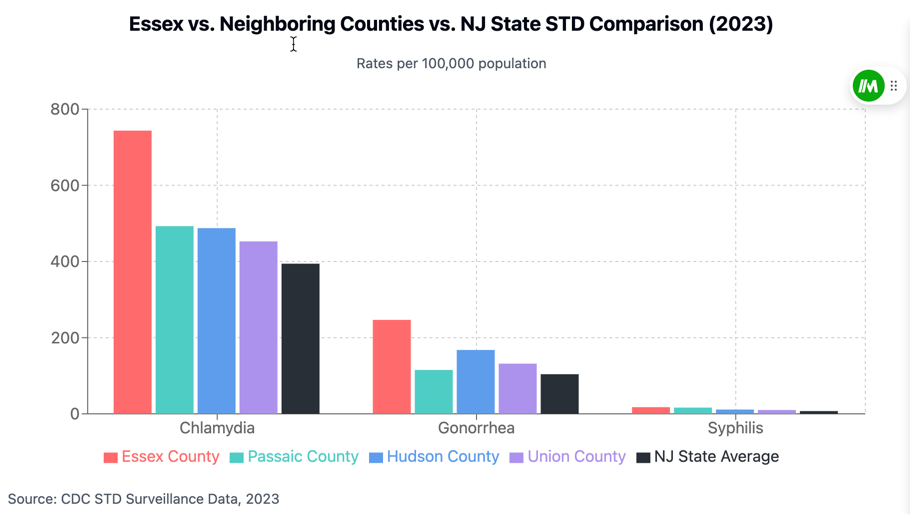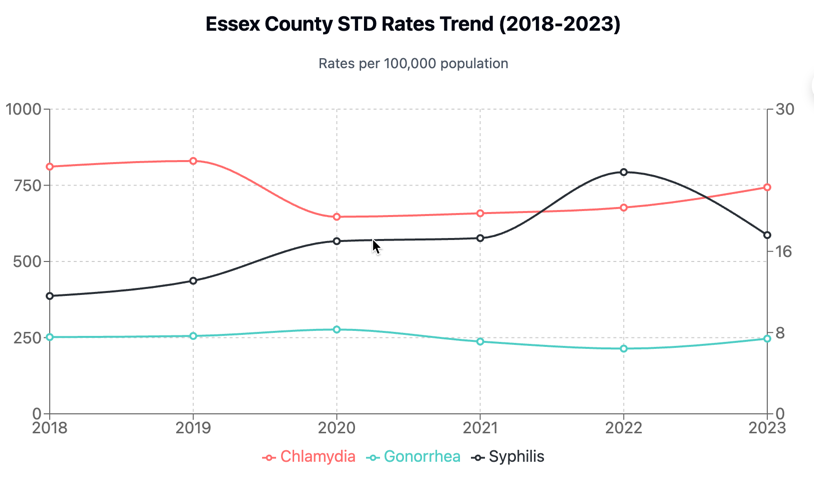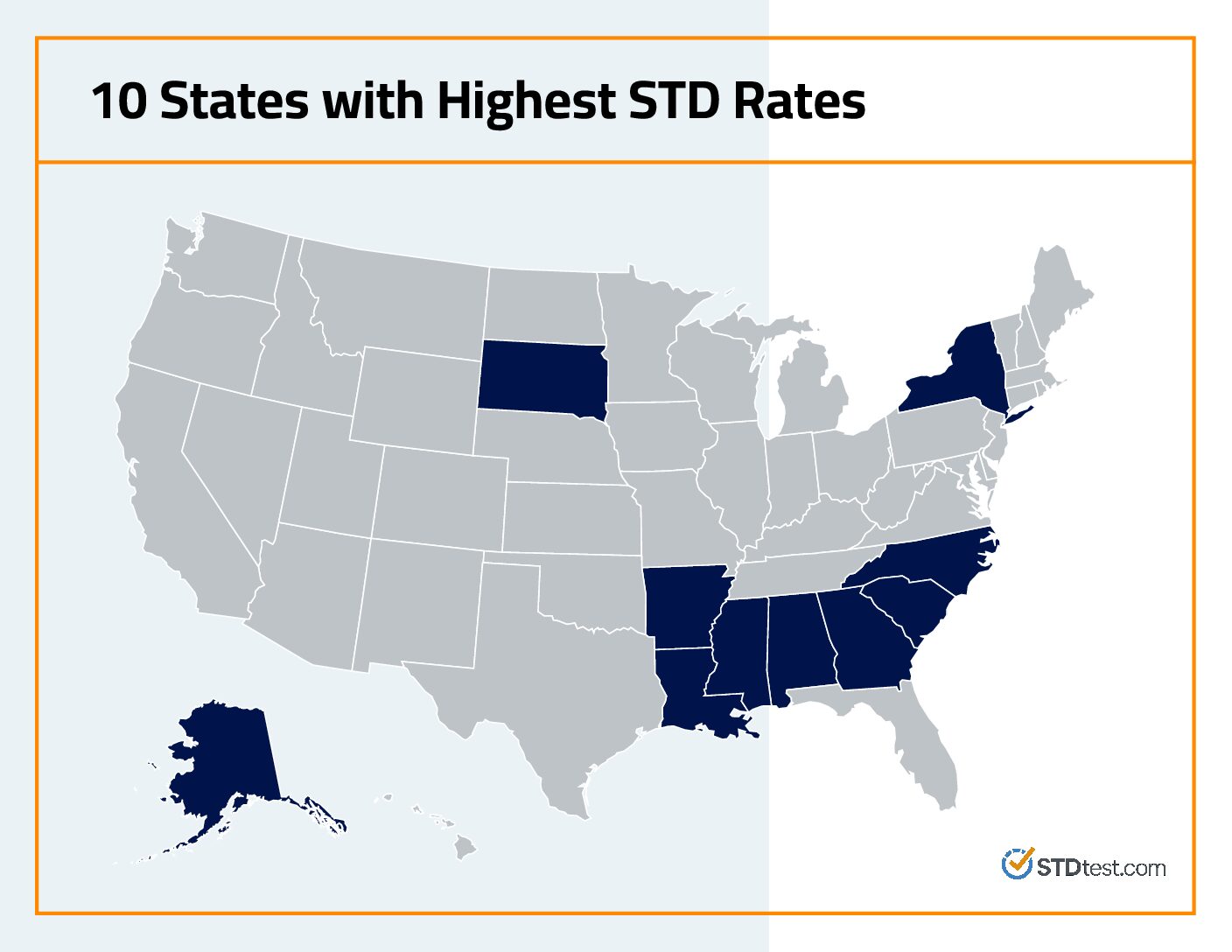In 2023, Essex County stood out with some of the highest STD rates in New Jersey, according to the latest CDC data. The county ranked #1 statewide for gonorrhea and syphilis rates, and #2 for chlamydia. These numbers reveal a real public health challenge that demands immediate attention.
The Numbers Tell a Concerning Story
Essex County ranks at or near the top of all New Jersey counties for sexually transmitted diseases, holding the #1 position for gonorrhea and syphilis rates, and #2 for chlamydia (behind Cumberland County). These rankings have been consistent over several years, highlighting an ongoing challenge.
In 2023, Essex County reported:
- 6,329 chlamydia cases (rate of 743.6 per 100,000 population)
- 2,100 gonorrhea cases (rate of 246.7 per 100,000)
- 150 primary and secondary syphilis cases (rate of 17.6 per 100,000)
These rates significantly exceed both the state average and rates in many neighboring counties. For perspective, Essex County’s STD rates are approximately:
- 89% higher than the New Jersey state average for chlamydia
- 137% higher than the state average for gonorrhea
- 141% higher than the state average for syphilis
How Essex County STD Rates Compare to Neighbors and State Averages

Essex County consistently shows higher STD rates than both the state average and all neighboring counties. Among surrounding counties, Passaic, Hudson, and Union counties also show concerning rates, though still significantly lower than Essex.
When comparing neighboring counties’ chlamydia rates in 2023 (per 100,000 population):
- Essex: 743.6
- Passaic: 492.8
- Hudson: 487.6
- Union: 452.7
- Bergen: 236.3
This pattern holds true for gonorrhea and syphilis as well, with Essex County showing substantially higher rates across all three major STDs than its neighbors.
Trends Over Time

The data shows some concerning shifts in Essex County over the past six years:
- Chlamydia: After dropping during the pandemic years (2020-2021), rates have increased 9.9% from 2022 to 2023
- Gonorrhea: Increased by 15.3% from 2022 to 2023
- Syphilis: While down 26.1% from the 2022 peak, rates remain significantly higher than pre-pandemic levels
Who’s Most at Risk?
Essex County and national statistics provide insight into which groups typically face higher STD risks:
According to the CDC, young people aged 15-24 account for nearly half of all new STD infections nationwide, despite representing just 25% of the sexually active population. Urban areas with limited healthcare access also tend to have higher infection rates. Social determinants of health—including poverty, stigma, discrimination, and limited access to quality healthcare—all contribute to STD disparities among different populations.
A significant challenge in addressing STDs is that many infections remain asymptomatic. The Cleveland Clinic estimates that as many as many as 70% of chlamydia cases may go undiagnosed because individuals don’t experience symptoms or don’t get tested. This highlights the importance of routine screening, particularly in high-prevalence areas like Essex County where expanding testing opportunities in underserved communities remains a public health priority.
What This Means For You
For Parents
The high STD rates highlight the importance of age-appropriate conversations about sexual health. Resources like Planned Parenthood of Northern, Central and Southern New Jersey offer guidance on how to discuss these topics with teens.
For Young Adults
Regular testing is essential, especially if you’re sexually active with multiple partners. Many STDs don’t show symptoms initially but can cause serious health problems if left untreated. Testing is available at multiple locations throughout Essex County, including:
The remainder of the cities and towns can be found on our NJ State Testing page
For Healthcare Providers
The data underscores the need for routine STD screening, particularly among young adults during National STD Awareness Month. Consider implementing opt-out testing protocols and enhancing community outreach efforts.
FAQs
How often should I get tested for STDs?
If you’re sexually active, consider getting tested at least once a year. More frequent testing (every 3-6 months) is recommended if you have multiple partners or don’t consistently use protection.
Are STD tests covered by insurance in Essex County?
Most insurance plans, including Medicaid, cover STD testing. Many health departments and community clinics also offer free or low-cost testing.
What STDs should I be tested for?
Common STD screenings include chlamydia, gonorrhea, syphilis, and HIV. Your healthcare provider may recommend additional tests based on your risk factors.
Can STDs be cured?
Bacterial STDs like chlamydia, gonorrhea, and syphilis can be cured with antibiotics if caught early. Viral STDs like herpes and HIV cannot be cured but can be managed with medication.
What happens if STDs are left untreated?
Untreated STDs can lead to serious health problems, including infertility, chronic pain, certain cancers, and increased risk of HIV transmission. Some can also be passed to babies during pregnancy or birth.
STI Prevention Works
The good news? STDs are preventable. Strategies include:
- Consistent and correct condom use
- Regular testing
- Open communication with partners about sexual health
- Limiting number of sexual partners
- Getting vaccinated against HPV and hepatitis B
By taking these steps and utilizing available resources, Essex County residents can protect their health and help reduce the concerning STD rates in our community.
Sources
CDC STD Surveillance Report: https://www.cdc.gov/sti-statistics/annual/index.html
NJ Dept of Health: https://www.nj.gov/health/sti/






